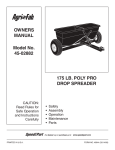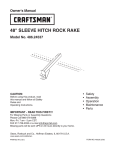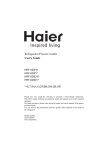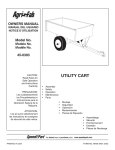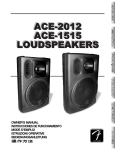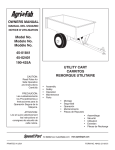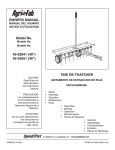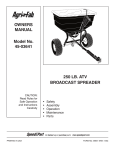Download Agri-Fab HA21362 User's Manual
Transcript
™ owners manual NOTICE D’UTILISATION MANUAL DEL USUARIO Model No. Modèle No. Modelo No. 45-0464 CAUTION: Read Rules for Safe Operation and Instructions Carefully ATTENTION: Lire et suivre attentivement les instructions et consignes de sécurité de cette notice. PRECAUCION: Lea cuidadosamente los Procedimientos e Instrucciones para la Operación Segura de la Máquina. poly dump cart CHARIOT BASCULANT EN PLASTIQUE CARRETILLA VOLCADORA DE PLÁSTICO IMPORTANT! Add grease to wheel bearings before using cart. IMPORTANT! Ajoutez de la graisse sur les roulements à billes avant d’utiliser le chariot. ¡IMPORTANTE! Aplique grasa a los cojinetes de las ruedas antes de usar la carretilla • • • • • Safety Assembly Operation Maintenance Parts • • • • • Sécurité Assemblage Fonctionnement Maintenance Pièces de Rechange • • • • • Seguridad Montaje Operación Mantenimiento Piezas de Repuesto the fastest way to purchase parts www.speedepart.com PRINTED IN USA FORM NO. 41153 (02/25/09) SAFETY RULES Remember, any power equipment can cause injury if operated improperly or if the user does not understand how to operate the equipment. Exercise caution at all times when using power equipment. CAUTION: VEHICLE BRAKING AND STABILITY MAY BE AFFECTED WITH THE ADDITION OF AN ACCESSORY OR AN ATTACHMENT. BE AWARE OF CHANGING CONDITIONS ON SLOPES. LOOK FOR THIS SYMBOL TO POINT OUT IMPORTANT SAFETY PRECAUTIONS. IT MEANS — ATTENTION! BECOME ALERT! YOUR SAFETY IS INVOLVED. • • • • • • • • • • • • Read this owners manual before attempting to assemble or operate the cart. Read the vehicle owners manual and know how to operate your tractor before using the cart attachment. Do not at any time carry passengers in this cart. It has not been designed to carry passengers. Never allow children to operate the tractor or the cart attachment. Do not allow adults to operate the tractor or cart attachment without proper instructions. Always begin with the transmission in first (low) and gradually increase speed as conditions permit. Maximum towing speed is 10 m.p.h. Do not tow this cart on highways or public thoroughfares. Tow the cart at reduced speed over rough terrain and hillsides or near creeks and ditches to prevent tipping over and loss of control. Do not drive too close to a creek or ditch. Vehicle braking and stability may be affected with the attachment of this cart. Do not fill cart to maximum weight capacity without checking the capability of the towing vehicle to safely pull and stop with the cart attached. Before operating vehicle on any grade (hill) refer to safety rules in the vehicle owner's manual concerning safe operation on slopes. Refer also to the slope guide on page 13 of this manual. Be aware of changing conditions on slopes. Stay off steep slopes! Follow maintenance and lubrication instructions as outlined in this manual. CARTON CONTENTS 1 6 10 2 41009 26533 41008 9 24497 5 24498 3 5 8 4 26584 25106 ref 1 2 3 4 5 25636 42159 description ref 6 7 8 9 10 Tailgate Cart Bed Wheel Support Axle Wheel 2 description Latch Stand Bracket Hitch Bracket Tongue Latch Lock Bracket Step Bracket 7 23014 shown full size 16 11 13 12 14 15 x1 HA21362 x1 x8 x1 x2 x4 17 43182 43661 43001 x11 47810 43840 21 18 22 20 x2 46980 x4 x1 19 x2 x4 47189 43601 43343 47407 23 43093 not shown full size 25 x2 x1 43014 26 27 47408 24 47622 x1 x2 44678 ref 11 12 13 14 15 16 17 18 19 23353 description Hex Bolt, 5/16-18 x 4" Hex Bolt, 5/16-18 x 1-1/4" Hex Bolt, 3/8-16 x 1" Hex Bolt, 5/16-18 x 3/4" Hex Bolt, 1/4-20 x 1" Nylock Nut, 3/8" Nylock Nut, 5/16" Sims Nut, 5/16" Nylock Nut, 1/4" ref 20 21 22 23 24 25 26 27 3 description Washer, 1" Hair Cotter Pin, 3/32 x 2-5/16" Cotter Pin, 1/8 x 1-1/2" Hub Cap Spacer, 1.03 x .25 x 2.06" Extension Spring Hitch Pin, 3/8 x 3" Spring Puller Tool x1 ASSEMBLY INSTRUCTIONS 3. Turn cart over and place tongue (8) on latch stand bracket (6) and wheel support (3). 4. Slide axle through wheel support and tongue. TOOLS REQUIRED FOR ASSEMBLY (2) (2) (2) (1) (1) 9/16" Wrenches 1/2" Wrenches 7/16" Wrenches Pliers Grease Gun tongue 1. Attach the wheel support (3) to the middle of the cart bed (2) using eight 5/16 x 1-1/4" hex bolts (12) and 5/16" nylock nuts (17). Tighten. axle 5/16 x 1-1/4" hex bolt FIGURE 3 5. Assemble the step bracket (10) to the latch lock bracket (9) using two 5/16 x 3/4" hex bolts (14) and 5/16" nylock nuts (17). Tighten. 5/16" nylock nut 5/16 x 3/4" hex bolt step bracket latch lock bracket wheel support FIGURE 4 5/16" nylock nut 6. Slide the step bracket (10) and latch lock bracket (9) into the slot in the tongue (8). 7. Secure the step bracket (10) and latch lock bracket (9) to the tongue (8) using a 5/16 x 4" hex bolt (11), a 5/16" sims nut (18) on each side of the brackets and a 5/16" nylock nut (17). Do not over tighten nylock nut, the bolt must pivot. 8. Attach the short end of extension spring (25) to the hole at the bottom of the latch lock bracket (9). 9. Use the spring puller (27) tool to pull the long end of the extension spring (25) down and attach it to the tongue (8). FIGURE 1 2. Assemble the latch stand bracket (6) to the cart bed using four 1/4 x 1" hex bolts (15) and 1/4" nylock nuts (19). Tighten. 1/4 x 1" hex bolt 5/16" x 4" hex bolt 5/16" sims nut 5/16" nylock nut latch stand bracket 1/4" nylock nut extension spring spring puller tool FIGURE 2 FIGURE 5 4 operation 10. Assemble a spacer (24), a 1" washer (20), a wheel (5) (valve stem facing out), and then another 1" washer (20) to the axle (4). 11. Secure with a 1/8 x 1-1/2" cotter pin (22), spreading the ends of the cotter pin with a pair of pliers bending the ends around the axle. 12. Press hub cap (23) onto washer on outside of wheel. 13. Add grease to wheel bearings using a grease gun. 14. Repeat for other wheel. 1/8 x 1-1/2" cotter pin CAUTION: Vehicle braking and stability may be affected with the addition of an accessory or attachment. Be aware of changing conditions on slopes. do not exceed 800 lb. capacity of cart One cubic foot of dirt weighs approximately 80 lbs. 1. The maximum towing speed for this cart is 10 m.p.h. 2. Refer to vehicle owners manual for instructions on safe operation on slopes. 3. Use slope guide provided on page 13 of this manual to determine whether a slope angle is too steep for safe operation. 4. Always test to make sure your tractor has adequate towing and braking capabilities whenever hauling a substantial amount of weight in your cart. Use extra caution when operating on slopes. 5. For best handling and traction, distribute the weight of the load evenly in the cart. 6. To dump material from the cart, remove the tailgate from rear of cart and then step down on latch step bracket. After emptying, pull the front of the bed down toward the cart tongue until the latch snaps into place. Reinstall tailgate. 1" washer spacer wheel hub cap ADD GREASE FIGURE 6 CAUTION: To avoid possible injury, be sure no one is near cart before releasing latch. 15. Slide hitch into slot at end of tongue (8) and secure with a 3/8 x 1" hex bolt (13) and 3/8" nylock nut (16). 16. Assemble hitch pin (26) to hitch bracket (7) and tongue (8) and secure with a hair cotter pin (21). MAINTENANCE 1. Check for loose fasteners before each use. 2. Check for worn or damaged parts before each use. 3. Keep tires filled to recommended tire pressure printed on the tire. hitch pin CAUTION: DO NOT inflate tires beyond the maximum recommended pressure printed on side of tire. 3/8 x 1" hex bolt 4. At the beginning of each season, using a light machine oil, lubricate the latch and the latch pivot bolt. 5. Pump grease into grease fittings on wheels periodically (at least once each season). hitch bracket 3/8" nylock nut hair cotter pin STORAGE FIGURE 7 1. Clean thoroughly before storing. 2. Remove any rust from painted surfaces and coat with touch up paint. 3. Store in a dry area. 5 CONSIGNES DE SÉCURITÉ N’oubliez pas que tout appareil mécanique ou motorisé risque de provoquer des blessures si ce dernier n'est pas utilisé correctement ou si l'utilisateur ne sait pas comment l'utiliser. Faites preuve de prudence à tout moment lorsque vous utilisez un appareil mécanique ou motorisé. ATTENTION: LE FREINAGE ET LA STABILITÉ DU VÉHICULE RISQUENT D'ÊTRE AFFECTÉS EN RACCORDANT UN ACCESSOIRE. PRENEZ EN COMPTE DE CETTE DIFFÉRENCE LORSQUE VOUS CONDUISEZ SUR UNE PENTE. CE SYMBOLE INDIQUE DES CONSIGNES DE SÉCURITÉ IMPORTANTES. IL SIGNIFIE: ATTENTION! SOYEZ VIGILANT! VOTRE SÉCURITÉ EN DÉPEND! • • • • • • • • • • • • Lisez ce manuel avant de tenter d’assembler ou d’utiliser le chariot. Lisez le manuel d'utilisation du véhicule et veillez à bien connaître le fonctionnement du tracteur avant d'utiliser le chariot Ne laissez personne s’asseoir sur le chariot et ne transportez jamais personne sur le chariot. Cet article n’a pas été conçu afin de pouvoir transporter des passagers. Ne laissez jamais d'enfants utiliser la balayeuse. Ne laissez aucun adulte utiliser le tracteur ni le chariot sans lui avoir fourni auparavant les instructions adéquates. Commencez toujours en veillant à ce que le levier de la transmission se trouve en première vitesse (réglage bas sur "low") et augmentez petit à petit votre vitesse si les conditions le permettent. Vitesse de remorquage maximum : 10 mph (16 km/h). Ne pas remorquer ce chariot sur une route quelconque ou sur la voie publique. Tractez le chariot à basse vitesse sur terrain accidenté, sur une pente et le long d’un ruisseau ou d’un fossé afin d'éviter qu'il ne se renverse en cas de perte de contrôle du véhicule. Veillez à ne pas conduire trop près d’un ruisseau ou d’un fossé. Le freinage et la stabilité du véhicule risquent d'être affectés en raccordant le chariot. Veillez à ne pas remplir le chariot au poids maximum autorisé sans avoir vérifié que le véhicule est capable de tracter le chariot et de s'arrêter sans danger avec ce dernier. Tenez-vous à l'écart de toute pente forte! Avant de conduire le véhicule sur une pente quelconque (colline), reportez-vous aux consignes de sécurité du manuel d'utilisation du véhicule concernant sa conduite sur une pente. Reportez-vous au guide de calcul d’une pente à la page 14 de ce manuel. Tenezvous à l'écart de toute pente forte! Veillez à suivre les instructions d’entretien et de lubrification du chapitre consacré à la maintenance. CONTENU DU CARTON 1 6 10 2 41009 26533 41008 9 24497 5 24498 3 5 8 4 26584 25106 ref 1 2 3 4 5 25636 42159 description Hayon arrière Plateau du chariot Support de roue Essieu Roue ref 6 7 8 9 10 6 description Support du verrou Support d’attelage Barre d’attelage Support du mécanisme de verrouillage Levier du mécanisme de verrouillage 7 23014 ASSEMBLAGE 3. Placez le chariot à l’envers et placez la barre d’attelage (8) sur le support du mécanisme de verrouillage (9) et le support de roues (3). 4. Glissez l’essieu à travers le support de roues (3) et la barre d’attelage (8). OUTILS NÉCESSAIRES POUR L’ASSEMBLAGE Deux (2) clés de 9/16 po. (14 mm) Deux (2) clés de 1/2 po. (12 mm) Deux (2) clés de 7/16 po. (11 mm) Une (1) paire de pinces Un (1) pistolet graisseur BARRE D’ATTELAGE 1. Fixez le support de roues (3) au centre plateau du chariot (2) en utilisant huit boulons hexagonaux de 5/16 x 1-1/4 po. (12) huit écrous à frein élastique de 5/16 po. (17) Serrez. ESSIEU BOULON HEXAGONAL DE 5/16 X 1-1/4 PO. ILLUSTRATION 3 5. Fixez le levier du mécanisme de verrouillage (10) en utilisant deux boulons hexagonaux de 5/16 x 3/4 po. (14) et deux écrous à frein élastique de 5/16 po. (17) Serrez. BOULON HEXAGONAL DE 5/16 X 3/4 PO. ÉCROU À FREIN ELASTIQUE DE 5/16 PO. LEVIER DU MÉCANISME DE VERROUILLAGE SUPPORT DU MÉCANISME DE VERROUILLAGE SUPPORT DE ROUE ILLUSTRATION 4 6. Glissez le levier du mécanisme de verrouillage (10) et le support du mécanisme de verrouillage (9) dans la fente de la barre d’attelage (8). 7. Fixez le levier du mécanisme de verrouillage (10) et le support du mécanisme de verrouillage (9) sur la barre d’attelage (8) en utilisant un boulon hexagonal de 5/16 x 4 po. (11), un écrou de 5/16 po. (18) de chaque côté des supports et un écrou à frein élastique de 5/16 po. (17) Ne pas trop serrer l’écrou à frein élastique car le boulon doit pouvoir tourner librement. 8. Fixez l’extrémité courte du ressort sur le trou situé au bas du support du mécanisme de verrouillage (9). 9. Utilisez l’outil fourni pour tirer sur l’extrémité du ressort et abaissez le ressort et fixez-le à la barre d’attelage (8). ÉCROU A FREIN ELASTIQUE DE 5/16 PO. ILLUSTRATION 1 2. Fixez le support du verrou (6) au chariot en utilisant quatre boulons hexagonaux de 1/4 x 1 po. (15) et quatre écrous à frein élastique de 1/4 po. (19) Serrez. BOULON HEXAGONAL DE 1/4 X 1 PO. BOULON HEXAGONAL DE 5/16 X 4 PO. ÉCROU DE 5/16 PO. RESSORT D’EXTENSION ÉCROU À FREIN ELASTIQUE DE 5/16 PO. SUPPORT DU VERROU ÉCROU À FREIN ELASTIQUE DE 1/4 PO. OUTIL POUR TIRER LE RESSORT ILLUSTRATION 2 ILLUSTRATION 5 7 UTILISATION 10. Installez sur l’essieu une entretoise (24), une rondelle de 1 po. (2,5 cm) (20), une roue (5) (avec la valve de gonflage vers l’extérieur) puis une autre rondelle de 1 po. (20) 11. Fixez une goupille cylindrique fendue de 1/8 x 1-1/2 po. (22), écartez les extrémités de la goupille avec une paire de pinces afin de les plier autour de l’essieu. 12. Placez un enjoliveur (23) sur la rondelle située sur l’extérieur de la roué en pressant. 13. Ajoutez de la graisse sur les roulements à bille à l’aide d’un pistolet graisseur. Répétez l’opération sur l’autre roue. GOUPILLE CYLINDRIQUE FENDUE DE 1/8 x 1-1/2 PO. ATTENTION: Le freinage et la stabilité du véhicule risquent d'être affectés en raccordant un accessoire. Prenez en compte cette différence lorsque vous conduisez sur une pente. NE PAS DÉPASSER LA CAPACITÉ DU CHARIOT QUI EST DE 800 LBS (363 KG) Un pied cube de terre pèse environ 80 lbs. (36 kg) 1. Vitesse de remorquage maximum : 10 mph (16 km/h). 2. Reportez-vous au manuel d’utilisation du vehicle afin de vous assurer que vous pouvez circuler sans danger sur une pente. 3. Reportez-vous au guide de calcul d’une pente à la page 14 de ce manuel pour déterminer si l’angle de la pente est trop fort pour circuler sans danger avec le tracteur. 4. Veillez à toujours faire un essai afin de vous assurer que le tracteur peut tirer et freiner lorsque vous remorquez le chariot s’il contient une grosse charge. Faites preuve de précaution lorsque vous roulez sur une pente. 5. Pour une meilleure tenue de route et une meilleure traction, répartissez le poids de la cargaison uniformément dans le chariot. 6. Pour vider le chariot, retirez le hayon arrière du chariot puis appuyez avec le pied sur le levier du mécanisme de verrouillage. Après avoir vidé le chariot, abaissez l’avant du plateau vers la barre d’attelage jusqu’à ce que le mécanisme de verrouillage se remette en place d’un bruit sec. Remettez en place le hayon arrière. RONDELLE DE 1 PO. (2,5 CM) ENTRETOISE ROUE ENJOLIVEUR AJOUTER LA GRAISSE ICI ILLUSTRATION 6 ATTENTION: Pour éviter tout risque de blessure, assurez-vous qu’il n’y a personne à proximité du chariot avant de libérer le levier. 14. Glissez le support d’attelage (7) dans la fente située au bout de la barre d’attelage (8) et fixez avec un boulon hexagonal de 3/8 x 1 po. (13) et un écrou à frein élastique de 3/8 po. (16) 15. Insérez la goupille d’attelage (26) dans le support d’attelage (7) et la barre d’attelage (8) et fixez la goupille en utilisant une goupille fendue (21). ENTRETIEN 1. Vérifiez que la visserie est correctement serrée. 2. Avant chaque utilisation, assurez-vous que les pièces ne sont pas usées ni endommagées 3. Maintenez les pneus à la pression maximum recommandée figurant sur le flanc du pneu. GOUPILLE D’ATTELAGE BOULON HEXAGONAL DE 3/8 X 1 PO. ATTENTION: NE PAS gonfler les pneus au-delà de la pression maximum recommandée sur le flanc du pneu. SUPPORT D’ATTELAGE 4. Au début de chaque saison, lubrifiez le mécanisme de verrouillage, le boulon du pivot de verrouillage avec une huile automobile légère. 5. Pompez à intervales réguliers de la graisse dans les raccords graisseurs (au moins une fois par saison). ÉCROU À FREIN ÉLASTIQUE 3/8 PO. GOUPILLE FENDUE REMISAGE ILLUSTRATION 7 1. Nettoyez complètement cet article avant de le remiser. 2. Retirez toute trace de rouille sur les surfaces peintes et appliquez de la peinture de retouche. 3. Remisez cet article dans un endroit sec. 8 REGLAS DE SEGURIDAD Recuerde, cualquier equipo movido por motor puede causar lesiones si se opera inadecuadamente o si el usuario no entiende cómo debe operarlo. Manténgase atento y cauteloso siempre que opere el equipo. PRECAUCIN: LA ESTABILIDAD DEL VEHÍCULOY SU CAPACIDAD DE FRENADO PUEDEN AFECTARSE AL REMOLCAR UN ACCESORIO O UN VEHÍCULO ADICIONAL. TENGA CUIDADO CON ESTE CAMBIO DE CONDICIONES DEBIDO A LA PENDIENTE. ESTE SÍMBOLO INDICA PRECAUCIONES IMPORTANTES DE SEGURIDAD. SIGNIFICA - ¡ATENCIÓN! SU SEGURIDAD ESTÁ EN RIESGO. • • • • • • • • • • • • • Manténgase atento y cauteloso siempre que opere el equipo. Lea este manual del usuario antes de ensamblar las piezas o usar el carrito Lea el manual del usuario del vehículo de remolque y aprenda cómo operar su tractor antes de usar el accesorio del carrito. Nunca transporte a pasajeros en este carrito. No ha sido diseñado para transportar a pasajeros. Nunca permita que los niños operen el tractor o el carrito y no permita tampoco que los adultos los operen sin haber recibido instrucción adecuada. Empiece siempre con la transmisión en primera (bajo) y con el motor a baja velocidad, y gradualmente aumente la velocidad según lo permitan las condiciones. Velocidad máxima de remolque: 10 mph (16 km/h) No remolque el carrito por carreteras o caminos públicos. Cuando remolque el carrito, no conduzca demasiado cerca de arroyos o zanjas, y manténgase alerta en cuanto a huecos u otros peligros que puedan ser causa de que usted pierda el control del tractor y del carrito. La estabilidad y capacidad de frenado del vehículo pueden afectarse al enganchar este carrito. No llene el carro a su capacidad de peso máximo sin haber verificado la suficiencia del vehículo tractor para remolcar el carro en forma segura y frenar adecuadamente con el carrito enganchado. Antes de operar el vehículo en cualquier pendiente (o colina), consulte las reglas de seguridad que aparecen en el manual del usuario del vehículo, relativas a la forma segura de operar en pendientes. Vea el guia de la página 15. ¡Manténgase alejado de pendientes escarpadas! No remolque este carrito en carreteras o caminos públicos. Observe las instrucciones de mantenimiento y lubricación, según se describen en este manual. CONTENIDO DE LA CAJA 1 6 10 2 41009 26533 41008 9 24497 5 24498 3 5 8 4 26584 25106 ref 1 2 3 4 5 25636 42159 DESCRIPCIÓN Compuerta trasera Plataforma de la carretilla Soporte de las ruedas Eje Rueda ref 6 7 8 9 10 9 DESCRIPCIÓN Soporte vertical de retención Soporte de enganche Lengüeta Soporte de retención y bloqueo Soporte escalonado 7 23014 INSTRUCCIONES DE ENSAMBLAJE 3. Voltee la carretilla y coloque la lengüeta (8) sobre el soporte vertical de retención (6) y el soporte de las ruedas (3). 4. Deslice el eje (4) a través del soporte de las ruedas (3) y la lengüeta (8). HERRAMIENTAS NECESARIAS PARA EL ENSAMBLAJE (2) (2) (2) (1) (1) Llaves de 9/16 pulg. Llaves de 1/2 pulg. Llaves de 7/16 pulg. Alicates Pistola de grasa LENGÜETA 1. Acople el soporte de las ruedas (3) al centro de la plataforma de la carretilla (2) con ocho pernos hexagonales de 5/16 x 1-1/4 pulg. (12) y tuerca de cierre de nylon (17). Apriete. EJE PERNO HEXAGONAL DE 5/16 X 1-1/4 PULG. FIGURA 3 5. Acople el soporte escalonado (10) al soporte de retención y bloqueo (9) con dos pernos hexagonales de 5/16 x 3/4 pulg. (14) y tuerca de cierre de nylon de 5/16 pulg. (17) Apriete. TUERCA DE CIERRE DE NYLON DE 5/16 PULG. PERNO HEXAGONAL DE 5/16 X 3/4 PULG. SOPORTE ESCALONADO SOPORTE DE RETENCIÓN Y BLOQUEO SOPORTE DE LAS RUEDAS FIGURA 4 6. Deslice el soporte escalonado (10) y el soporte de retención y bloqueo (9) en la ranura de la lengüeta (8). 7. Asegure el soporte escalonado (10) y el soporte de retención y bloqueo (9) a la lengüeta (8) con un perno hexagonal de 5/16 x 4 pulg. (11), una tuerca de 5/16 pulg. (18) a cada lado de los soportes y una tuerca de cierre de nylon de 5/16 pulg. (17) No apriete demasiado la tuerca de cierre de nylon. El perno debe girar. 8. Acople el extremo corto del resorte de extensión (25) al agujero situado en la base del soporte de retención y bloqueo (9). 9. Use el extractor de resorte (27) para jalar el extremo largo del resorte de extensión (25) hacia abajo y acoplarlo a la lengüeta (8). TUERCA DE CIERRE DE NYLON DE 5/16" FIGURA 1 2. Acople el soporte vertical de retención (6) a la plataforma de la carretilla (2) con cuatro pernos hexagonales de 1/4 x 1 pulg. (15) y tuerca de cierre de nylon de 1/4 pulg. (19) Apriete. PERNO HEXAGONAL DE 1/4 X 1 PULG. PERNO HEXAGONAL DE 5/16 PULG. X 4 PULG. TUERCA DE 5/16 PULG. TUERCA DE CIERRE DE NYLON DE 5/16 PULG. SOPORTE VERTICAL DE RETENCIÓN TUERCA DE CIERRE DE NYLON DE 1/4 PULG. RESORTE DE EXTENSIÓN EXTRACTOR DE RESORTE FIGURA 2 FIGURA 5 10 OPERACIÓN 10. Acople un separador (24), una arandela de 1 pulg. (20), una rueda (5) (vástago de la válvula orientado hacia fuera) y luego otra arandela de 1 pulg. (20) al eje (4). 11. Asegure con un pasador de chaveta de 1/8 x 1-1/2 pulg. (22); para ello extienda los extremos del pasador de chaveta con un par de alicates y doble los extremos alrededor del eje. 12. Presione la tapa de cubo (23) sobre la arandela en el lado exterior de la rueda. 13. Aplique grasa a los cojinetes de la rueda con una pistola de grasa. 14. Repita el procedimiento para la otra rueda. PASADOR DE CHAVETA DE 1/8 X 1-1/2 PULG. PRECAUCIÓN: Es posible que el frenado y la estabilidad del vehículo se vean afectados con la adición de un accesorio o acoplamiento. Preste atención a las condiciones cambiantes de las cuestas. NO EXCEDA LA CAPACIDAD DE LA CARRETILLA DE 800 LBS (363 KG) Un pie cúbico de tierra pesa aproximadamente 80 lbs. (36 kg) 1. La máxima velocidad de remolque de esta carretilla es 10 m.p.h. (16 km/h) 2. Consulte el manual del usuario del vehículo para obtener instrucciones sobre uso seguro en cuestas. 3. Use la guía sobre cuestas que se proporciona en la página 15 de este manual para determinar si el ángulo de inclinación de una cuesta es demasiado empinado para una operación segura. 4. Siempre verifique que su tractor tenga la capacidad adecuada de remolque y frenado al transportar una cantidad significativa de peso en la carretilla. Tome las precauciones debidas cuando use el vehículo en cuestas. 5. Para un mejor manejo y tracción, distribuya de manera pareja el peso de la carga en la carretilla. 6. Para vaciar el material de la carretilla, retire la compuerta trasera de la parte posterior de la carretilla y luego baje con el pie el soporte escalonado de retención. Después de vaciar el material, jale la parte frontal de la plataforma hacia abajo hacia la lengüeta de la carretilla hasta que el retén encaje en su lugar. Vuelva a instalar la compuerta trasera. ARANDELA DE 1 PULG. SEPARADOR RUEDA TAPA DE CUBO AÑADIR GRASA FIGURA 6 PRECAUCIÓN: Para evitar posibles lesiones personales, asegúrese de que ninguna persona esté cerca de la carretilla antes de soltar el retén. 15. Deslice el soporte de enganche (7) en la ranura situada en el extremo de la lengüeta (8) y fíjelo con un perno hexagonal de 3/8 x 1 pulg. (13) y una tuerca de cierre de nylon de 3/8 pulg. (16) 16. Acople el pasador de enganche (26) al soporte de enganche (7) y la lengüeta (8) y fíjelo con un pasador de horquilla. (21) MANTENIMIENTO 1. Antes de cada uso asegúrese de que no hayan pernos sueltos. 2. Antes de cada uso verifique que no hayan piezas desgastadas o dañadas. 3. Mantenga los neumáticos inflados según la presión de aire indicada en la llanta. PASADOR DE ENGANCHE PERNO HEXAGONAL DE 3/8 X 1 PULG. PRECAUCIÓN: NO exceda la máxima presión de inflado recomendada e indicada a un lado de la llanta. SOPORTE DE ENGANCHE 4. Al comienzo de cada temporada, lubrique el retén y el perno pivote de retención con aceite liviano para máquina 5. Ponga grasa periódicamente en las graseras de las ruedas (por lo menos una vez cada temporada). PERNO HEXAGONAL DE 3/8 X 1 PULG. PASADOR DE HORQUILLA ALMACENAMIENTO FIGURA 7 1. Limpie la unidad a fondo antes de guardarla. 2. Quite la corrosión de las superficies pintadas y retoque con una capa de pintura 3. Guarde la unidad en un área seca. 11 repair parts for 45-0464 poly dump cart 12 1 15 2 22 23 20 5 24 20 3 17 19 10 14 5 20 17 9 4 18 24 6 18 25 17 26 13 22 20 23 11 8 27 16 ref 1 2 3 4 5 6 7 8 9 10 11 12 13 14 part no 41009 41008 25106 25636 42159 24497 23014 26584 24498 26533 47407 43840 43001 43182 qty 1 1 1 1 2 1 1 1 1 1 1 8 1 2 description Tailgate Cart Bed Wheel Support Axle Wheel Latch Stand Bracket Hitch Bracket Tongue Latch Lock Bracket Step Bracket Hex Bolt, 5/16-18 x 4" Hex Bolt, 5/16-18 x 1-1/4" Hex Bolt, 3/8-16 x 1" Hex Bolt, 5/16-18 x 3/4" ref 15 16 17 18 19 20 21 22 23 24 25 26 27 12 part no 43661 HA21362 47810 46980 47189 43601 43343 43093 43014 44678 47408 23353 47622 41153 7 qty 4 1 11 2 4 4 1 2 2 2 1 1 1 1 21 description Hex Bolt, 1/4-20 x 1" Nylock Nut, 3/8" Nylock Nut, 5/16" Sims Nut, 5/16" Nylock Nut, 1/4" Washer, 1" Hair Cotter Pin, 3/32 x 2-5/16" Cotter Pin, 1/8 x 1-1/2" Hub Cap Spacer, 1.03 x .25 x 2.06" Extension Spring Hitch Pin, 3/8 x 3" Spring Puller Tool Owners Manual (Keep this sheet in a safe place for future reference.) Use this guide to determine if a slope is safe for the operation of your tractor and cart. Refer also to the instructions in your vehicle owners manual. SLOPE GUIDE SIGHT AND HOLD THIS LEVEL WITH A VERTICAL TREE A POWER POLE A CORNER OF A BUILDING OR A FENCE POST F O L D A LONG DOTTE D L IN E , REPR ESENT ING A 1 0 DEGRE E SLO PE CAUTION: DO NOT OPERATEYOUR TRACTOR AND CART ON A SLOPE IN EXCESS OF 10 DEGREES. BE SURE OF YOUR TRACTOR'S TOWING AND BRAKING CAPABILITIES BEFORE OPERATING ON A SLOPE. AVOID ANY SUDDEN TURNS OR MANEUVERS WHILE ON A SLOPE. 13 (Conservez cette feuille en lieu sûr pour référence future.) Utilisez ce guide afin de déterminer si une pente est sécuritaire pour l’utilisation de votre tracteur et de la remorque. Voir également les instructions incluses dans votre manuel d’utilisation du tracteur. GUIDE DE CALCUL D’UNE PENTE PLACEZ CETTE FEUILLE À NIVEAU CONTRE UN ARBRE DROIT UN POTEAU ÉLECTRIQUE LE COIN DE TOUT ÉDIFICE UN PIQUET DE CLÔTURE PLIEZ SELON L E S POINT ILLÉS, REP R É S E NTANT UNE P EN T E D E 10 D EGRÉS ATTENTION: NE PAS UTILISER LE TRACTEUR ET LA REMORQUE SUR UNE PENTE INCLINÉE À PLUS DE 10 DEGRÉS. VÉRIFIEZ LA TRAC TION ET LE FREINAGE DE VOTRE TRACTEUR AVANT DE CONDUIRE SUR UNE PENTE. ÉVITEZ TOUTE MANOEUVRE BRUSQUE LORSQUE VOUS CONDUISEZ SUR UNE PENTE. 14 (Mantenga esta guía en un lugar seguro para referencia futura.) Use esta guía para determinar si la operación de tractor y carrito es segura en una pendiente. Consulte también las instrucciones en el Manual del Usuario de su vehículo. GUIA DE PENDIENTES ALINEE LA LINEA VERTICAL DEL EXTREMO IZQUIERDO DEL GRAFICO CON UN OBJETO VERTICAL EN EL CAMPO, POR EJEMPLO UN POSTE DE CORRIENTE ELECTRICA O TELEFONO UNA ESQUINA DE UN EDIFICIO O UN POSTE DE UNA CERCA DO B L E L LA CUA A HOJA A LO L RE LAR P R E S ENTA U GO DE LA LIN NA PE NDIEN EA PUNTEA T E D E 10 G DA, RADOS PRECAUCION: NO OPERE EL TRACTOR REMOLCANDO EL CARRO EN UNA PENDIENTE DE MAS DE 10°. VERIFIQUE LA CAPACIDAD DE SU TRACTOR PARA REMOLCAR Y FRENAR ADECUADAMENTE ANTES DE OPERAR EN UNA PENDIENTE. EVITE GIROS O MANIOBRAS BRUSCAS CUANDO OPERA EN UNA PENDIENTE. 15 the fastest way to purchase parts www.speedepart.com REPAIR PARTS Agri-Fab, Inc. 809 South Hamilton Sullivan, IL. 61951 217-728-8388 www.agri-fab.com This document (or manual) is protected under the U.S. Copyright Laws and the copyright laws of foreign countries, pursuant to the Universal Copyright Convention and the Berne convention. No part of this document may be reproduced or transmitted in any form or by an means, electronic or mechanical, including photocopying or recording, or by any information storage or retrieval system, without the express written permission of Agri-Fab, Inc. Unauthorized uses and/or reproductions of this manual will subject such unauthorized user to civil and criminal penalties as provided by the United States Copyright Laws. © 2009 Agri-Fab, Inc.
This document in other languages
- français: Agri-Fab 45-0464
- español: Agri-Fab 45-0464
















